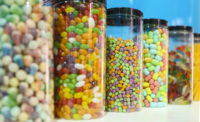It has revolutionized the snack industry in the West and is the go-to energy and muscle-building convenience boost for sports enthusiasts and fitness followers around the globe. Now the protein bar is being held up as a source of major opportunity for food and ingredients manufacturers in the Middle East.
With the snack bar market expected to grow rapidly in the coming years, there is rich potential for agile, innovative manufacturers in the region to cash in on a sector now worth $3 billion, with ease of access to an abundance of dates, fruits, seeds and nuts which find their way into today’s protein bars.
The potential of the versatile protein bar will be explored at Munch! stage, a new, three-day interactive knowledge platform which will make its debut at yummex Middle East, the MENA (Middle East and North Africa) region’s leading event for the sweets and snacks industry, which runs at Dubai World Trade Centre (DWTC) from Oct. 29-31.
Protein bars earn their place
The sweets and snacks market is currently gripped by a healthy transformation, and Munch! stage visitors will hear about the rapid rise of the protein and its popularity across the Middle East, Europe and the U.S.
“Protein bars have completely changed the snack and confectionery market in Europe and the USA, and first-movers in the Middle East could really capitalize here,” said Joe Katterfield, business development manager EMEA of Arla Foods Ingredients Group, the whey ingredients subsidiary of global dairy co-operative, Arla Foods.
Katterfield will drill down into consumer trends and highlight opportunities for the bars and how regional brands can produce them in his Oct. 30 session titled “Protein Bars: A Financial Godsend?”
“There is a growing number of health-conscious consumers aiming to control the portion of sweets they eat,” Katterfield said. “Snack bars and fruit snacks have shown higher demand as they are perceived as healthier than sweet biscuits so present a good alternative. I expect to see more protein fortification coming to the snack bars category. I will share insights about the booming global healthy snack trend of high protein snack bars and how this could present a commercial opportunity for regional snack producers in the Middle East.”
Fitness and convenience driving demand
Industry opportunities appear expansive with the yummex Middle East “Confectionery and Snacks” report citing MENA as one of the fastest-growing markets, which is forecast to be worth $34.5 billion by 2023 – up from the current $29.2 billion. Confectionery, snacks and ready-to-go foods currently account for 6.3 percent of all the region’s F&B spend.
The rise in popularity of the protein bar is down to several factors, including emerging fitness trends and high demand for convenience. According to data from Persistence Research, a specialized supplier of market intelligence reports, bars using plant-based protein dominate the market with animal protein a close second. Energy protein bars account for more than a third of global sales and are projected to gain share going forward. The super health conscious are now leaning towards high-protein snacks.
“Higher-quality protein, high protein content, low sugar and premium ingredients are favored by savvy consumers who are increasingly mindful of what they eat,” Katterfield said. “Delivering a high-quality protein bar with good taste and texture can often be complicated by these additional expectations. Now, we offer three protein bar solutions to help you create a final product that stands out in the marketplace and appeals exactly to what consumers are demanding.”
More potential for protein
The prospects for manufacturers in the region appear endless with protein now being tipped to help us stay stronger as we age.
“There is no denying protein is unique among macronutrients. Even though protein-derived amino acids can be used for energy purposes, its typically not high on the list of key nutrition roles,” reads a report by Arla Ingredients.
“This is contrary to carbohydrates and fats, which primarily operate as body energy resources. Digestion of dietary protein provides amino acids, which in turn, become the building blocks for hundreds of body proteins. Body proteins, importantly, serve as the basis of connective tissue for bone, skin, hair, and nails, as well as the tethering of organs to body movement via skeletal, cardiac and smooth muscle,” the report adds.
Analysts the world over are bullish on protein bar prospects and the market suggests its only gain in popularity. After Katterfield’s deep dive into the snack trend at Munch! stage, Middle East manufacturers could well decide to take a bite out of that.
The three-day Munch! platform will bring together the industry’s innovators and game changers to share and explore the latest trends, developments, regulatory updates and innovations to help manufacturers sustain their competitive edge.




